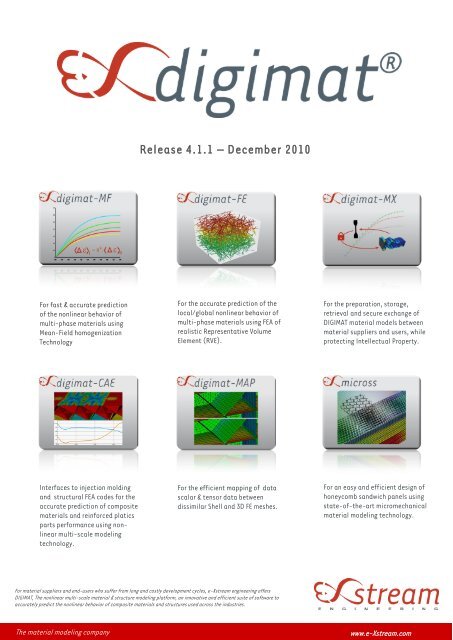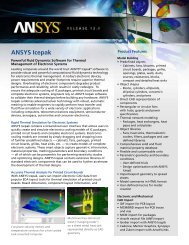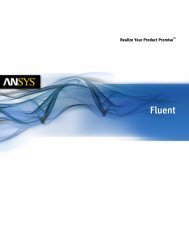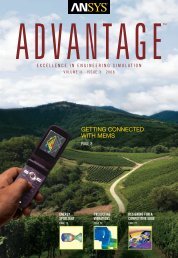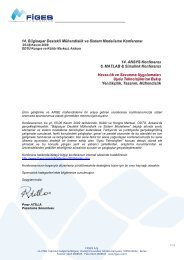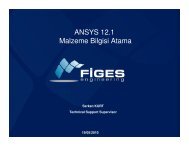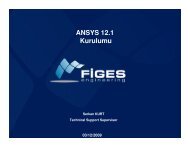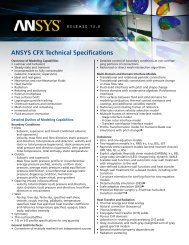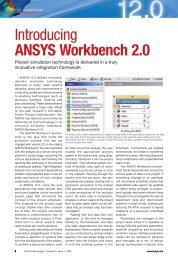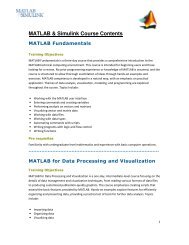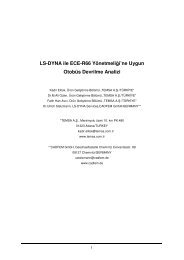DIGIMAT Brochure - Figes.com.tr
DIGIMAT Brochure - Figes.com.tr
DIGIMAT Brochure - Figes.com.tr
You also want an ePaper? Increase the reach of your titles
YUMPU automatically turns print PDFs into web optimized ePapers that Google loves.
Release 4.1.1 – December 2010<br />
For fast & accurate prediction<br />
of the nonlinear behavior of<br />
multi-phase materials using<br />
Mean-Field homogenization<br />
Technology<br />
For the accurate prediction of the<br />
local/global nonlinear behavior of<br />
multi-phase materials using FEA of<br />
realistic Representative Volume<br />
Element (RVE).<br />
For the preparation, storage,<br />
re<strong>tr</strong>ieval and secure exchange of<br />
<s<strong>tr</strong>ong>DIGIMAT</s<strong>tr</strong>ong> material models between<br />
material suppliers and users, while<br />
protecting Intellectual Property.<br />
Interfaces to injection molding<br />
and s<strong>tr</strong>uctural FEA codes for the<br />
accurate prediction of <s<strong>tr</strong>ong>com</s<strong>tr</strong>ong>posite<br />
materials and reinforced platics<br />
parts performance using nonlinear<br />
multi-scale modeling<br />
technology.<br />
For the efficient mapping of data<br />
scalar & tensor data between<br />
dissimilar Shell and 3D FE meshes.<br />
For an easy and efficient design of<br />
honey<s<strong>tr</strong>ong>com</s<strong>tr</strong>ong>b sandwich panels using<br />
state-of-the-art micromechanical<br />
material modeling technology.<br />
For material suppliers and end-users who suffer from long and costly development cycles, e-Xs<strong>tr</strong>eam engineering offers<br />
<s<strong>tr</strong>ong>DIGIMAT</s<strong>tr</strong>ong>, The nonlinear multi-scale material & s<strong>tr</strong>ucture modeling platform, an innovative and efficient suite of software to<br />
accurately predict the nonlinear behavior of <s<strong>tr</strong>ong>com</s<strong>tr</strong>ong>posite materials and s<strong>tr</strong>uctures used across the indus<strong>tr</strong>ies.<br />
The material modeling <s<strong>tr</strong>ong>com</s<strong>tr</strong>ong>pany<br />
www.e-Xs<strong>tr</strong>eam.<s<strong>tr</strong>ong>com</s<strong>tr</strong>ong>
Digimat-MF aims at predicting the nonlinear mechanical, thermal and elec<strong>tr</strong>ic behavior of<br />
multi-phase materials based on the constitutive properties of the base materials and the<br />
<s<strong>tr</strong>ong>com</s<strong>tr</strong>ong>posite morphology (inclusion weight fraction, length and orientation).<br />
Digimat-MF is accurate, efficient and very easy to learn and use.<br />
NEW IN <s<strong>tr</strong>ong>DIGIMAT</s<strong>tr</strong>ong> 4.1<br />
Thermo-elastoplastic & thermo-elastoviscoplastic material models<br />
Viscoelastic-viscoplastic material models insensitive to time steps<br />
Transversely iso<strong>tr</strong>opic and ortho<strong>tr</strong>opic Ohm & Fourier laws<br />
Improved discretization scheme of the orientation dis<strong>tr</strong>ibution function (ODF)<br />
GUI improvements:<br />
- Redesign of failure indicator definition<br />
- Redesign of piece-wise linear function capability<br />
- 2D plots( Probing, grid, box zoom), Histogram capabilities<br />
New GUI functionalities<br />
User defined outputs<br />
New outputs section to customize<br />
outputs requests<br />
MAIN CAPABILITIES<br />
Nonlinear (per-phase) Material Models<br />
Homogenization Methods<br />
Creep capabilities with new thermoelastoviscoplastic<br />
material model<br />
Linear thermo-elasticity<br />
- Aniso<strong>tr</strong>opic phases<br />
- Temperature-dependent properties<br />
Linear viscoelasticity<br />
Elasto-plasticity:<br />
- Iso<strong>tr</strong>opic hardening: power, exponential<br />
or exponential linear laws<br />
- Small deformation with large rotation<br />
Cyclic elasto-plasticity: Kinematic hardening; linear<br />
with restoration<br />
Pressure-dependent elasto-plasticity (Drucker-Prager)<br />
Elasto-plasticity with damage (Lemaî<strong>tr</strong>e-Chaboche)<br />
Elasto-viscoplastic : Creep models: Norton laws, Power laws,<br />
Prandtl law<br />
Viscoelasticity-viscoplasticity<br />
Hyperelastic (finite s<strong>tr</strong>ain): neo-Hookean, Mooney-Rivlin,<br />
Ogden, Swanson, Storakers (<s<strong>tr</strong>ong>com</s<strong>tr</strong>ong>pressible foams)<br />
Elasto-viscoplastic (finite s<strong>tr</strong>ain): Leonov-EGP<br />
Thermal & elec<strong>tr</strong>ical conductivity: Ohm & Fourier<br />
Micros<strong>tr</strong>ucture Morphology<br />
Multiple reinforcement phases<br />
Multi-layer micros<strong>tr</strong>ucture<br />
Ellipsoidal reinforcements (fillers, fibers, platelets)<br />
Aspect ratio dis<strong>tr</strong>ibution<br />
General orientation (fixed, random, 2 nd order orientation tensor)<br />
Void inclusions<br />
Coated inclusions with relative or absolute thickness<br />
Deformable, quasi-rigid or rigid inclusions<br />
Mori-Tanaka<br />
Interpolative double inclusion<br />
1 st and 2 nd order homogenization schemes<br />
Multi-step, multi-level homogenization methods<br />
High quality ODF recons<strong>tr</strong>uction method: Ortho<strong>tr</strong>opic method<br />
Failure Indicators<br />
Applied at micro and/or macro scale, or on pseudo-grains using<br />
the FPGF model (First Pseudo-Grain Failure model)<br />
Failure models: Max s<strong>tr</strong>ess and Max s<strong>tr</strong>ain, Tsai-Hill 2D & 3D, Azzi-<br />
Tsai-Hill 2D, Tsai-Wu 2D & 3D, Hashin-Rotem 2D, Hashin 2D & 3D<br />
S<strong>tr</strong>ain rate dependent failure criteria<br />
Failure criteria on Leonov-EGP & hyperelastic material models<br />
Loading<br />
Monotonic, cyclic or user-defined history loading<br />
Multi-axial s<strong>tr</strong>ess or s<strong>tr</strong>ain, General 2D & 3D<br />
Mechanical and thermo-mechanical<br />
Prediction of thermal & elec<strong>tr</strong>ical conductivities<br />
Loading definition from s<strong>tr</strong>uctural FEA results, i.e. Abaqus ODB file<br />
Iso<strong>tr</strong>opic Ex<strong>tr</strong>action Methods<br />
General<br />
Spec<strong>tr</strong>al<br />
Modified spec<strong>tr</strong>al<br />
More Functionalities<br />
Prediction of ortho<strong>tr</strong>opic engineering constants<br />
Multi-analyses capability<br />
Interoperability with Digimat-FE and Digimat-MX<br />
Handling of encrypted material files<br />
Partial unloads<br />
Damaging in a Lemaî<strong>tr</strong>e-Chaboche material<br />
t<br />
User-defined loading with intermediate unloadings used to identify<br />
the end of the elastic regime<br />
Multi-layer micros<strong>tr</strong>ucture<br />
Viscoelastic-Viscoplastic model: S<strong>tr</strong>ain rate dependency<br />
accounted on overall range of deformation<br />
Prediction of temperature dependent<br />
coefficient of thermal expansion<br />
<s<strong>tr</strong>ong>DIGIMAT</s<strong>tr</strong>ong>; The nonlinear multi-scale material & s<strong>tr</strong>ucture modeling platform
Digimat-FE is used to generate realistic Representative Volume Element (RVE) for a large<br />
variety of material micros<strong>tr</strong>uctures (plastics, rubbers, metals, graphite,...). The resulting<br />
finite element models are solved using major FEA software. Digimat-FE has an extensive set<br />
of capabilities that enable user-friendly generation of ex<strong>tr</strong>emely <s<strong>tr</strong>ong>com</s<strong>tr</strong>ong>plex material micros<strong>tr</strong>ucture<br />
morphologies that are accurately modeled at a reasonable CPU cost.<br />
NEW IN <s<strong>tr</strong>ong>DIGIMAT</s<strong>tr</strong>ong> 4.1<br />
New post-processing capabilities: summary of RVE generation<br />
process as well as features to validate the RVE geome<strong>tr</strong>y.<br />
Improved handling of size dis<strong>tr</strong>ibution<br />
GUI improvements:<br />
- 2D plots: Probing, grid, box zoom<br />
- Histogram capabilities<br />
Single results file grouping fields ex<strong>tr</strong>acted from ABAQUS ODB file<br />
MAIN CAPABILITIES<br />
Definition of Composite Constituents<br />
Inclusion shapes: any shape imported from a geome<strong>tr</strong>y file: spheroids, platelets, ellipsoids,<br />
cylinders (capped or not), prisms, polyhedrons made of 20 faces (icosahedrons)<br />
Definition of the constituents’ material behavior: elastic & thermo-elastic, viscoelastic,<br />
hyperelastic & thermo-hyperelastic, elastoplastic, elasto-viscoplastic, thermal, elec<strong>tr</strong>ical<br />
Inter operability with Digimat-MF and Digimat-MX for material definition<br />
New post-processing capabilities of the generated RVE geome<strong>tr</strong>y<br />
Micros<strong>tr</strong>ucture Definition<br />
Micros<strong>tr</strong>ucture morphology definition:<br />
- Volume or mass content<br />
- Multiple reinforcement phases<br />
- Ellipsoidal reinforcements (fillers, fibers, platelets)<br />
- General orientation definition (fixed, random, 2 nd order orientation tensor)<br />
- Possibility to model void inclusions, coated inclusions with relative or absolute<br />
thickness & clustering of inclusions<br />
Multi-layer micros<strong>tr</strong>ucture<br />
Filler/Ma<strong>tr</strong>ix debonding<br />
RVE Generation<br />
Micros<strong>tr</strong>ucture generation with real-time preview<br />
& Animation of RVE generation process<br />
Maximum packing algorithm<br />
2D RVE generation<br />
RVE Loading Definition, Export<br />
Monotonic, cyclic or user-defined history loading<br />
Multi-axial s<strong>tr</strong>ess or s<strong>tr</strong>ain, General 2D & 3D<br />
Mechanical and thermo-mechanical<br />
Prediction of thermal and elec<strong>tr</strong>ical conductivities<br />
Computation of the percolation threshold<br />
Loading definition from s<strong>tr</strong>uctural FEA, i.e. Abaqus ODB file<br />
Export of RVE geome<strong>tr</strong>y in <s<strong>tr</strong>ong>com</s<strong>tr</strong>ong>mon formats: STEP, IGES, BREP<br />
Export geome<strong>tr</strong>y and model definition to Abaqus/CAE<br />
Export geome<strong>tr</strong>y to ANSYS Workbench<br />
FE Meshing<br />
Geome<strong>tr</strong>y export to Abaqus/CAE and ANSYS Workbench<br />
Automatic adaptative mesh seeding and iterative mesh generation in Abaqus/CAE<br />
RVE meshing using embedded beam elements, s<strong>tr</strong>aight or curved<br />
The material modeling <s<strong>tr</strong>ong>com</s<strong>tr</strong>ong>pany<br />
Basic inclusion shapes<br />
Mesh generation in ABAQUS/CAE<br />
Decohesion seen at the tip of the<br />
fibres using shell cohesive ele-<br />
S<strong>tr</strong>ess dis<strong>tr</strong>ibution in fiber reinforced materials<br />
Micros<strong>tr</strong>ucture generation<br />
of metal ma<strong>tr</strong>ix <s<strong>tr</strong>ong>com</s<strong>tr</strong>ong>posites<br />
Multi-layered micros<strong>tr</strong>uctures<br />
Percolation path shown with black inclusions<br />
Statistical dis<strong>tr</strong>ibution of ma<strong>tr</strong>ix s<strong>tr</strong>esses<br />
www.e-Xs<strong>tr</strong>eam.<s<strong>tr</strong>ong>com</s<strong>tr</strong>ong>
The Material eXchange system is used to prepare, to store, to re<strong>tr</strong>ieve and to securely exchange<br />
<s<strong>tr</strong>ong>DIGIMAT</s<strong>tr</strong>ong> material models between material suppliers and end-users, while protecting the Intellectual<br />
Property of the involved parties.<br />
Digimat-MX is based on a cluster of material databases and the numerical tools needed to<br />
identify material law parameters and to reverse engineer missing data from a limited set of<br />
experimental measurements.<br />
NEW IN <s<strong>tr</strong>ong>DIGIMAT</s<strong>tr</strong>ong> 4.1<br />
Access new material data thanks to:<br />
- New material grades in MXDB<br />
- Interface to Material Data Center (CAMPUS)<br />
New reverse-engineering capabilities<br />
- S<strong>tr</strong>ength parameters of failure indicators<br />
- Thermal dependencies of thermo-mechanical material parameters<br />
- Aspect ratio of inclusion phase<br />
- Perform a reverse-engineering over a specified s<strong>tr</strong>ain range<br />
- New procedure for reverse engineering of viscoelastic materials based on<br />
equivalent numerical relaxation tests<br />
Enhanced database scheme: Allowing to store failure related information of DIGI-<br />
MAT material models and experimental data.<br />
Optimization of outputs generated during RE allowing a significant hard disk space reduction<br />
MAIN CAPABILITIES IN 4.1<br />
Material database<br />
Gives access to:<br />
- Experimental data (<strong>tr</strong>action, <s<strong>tr</strong>ong>com</s<strong>tr</strong>ong>pression, ...)<br />
- <s<strong>tr</strong>ong>DIGIMAT</s<strong>tr</strong>ong> material and analysis files for homogeneous or <s<strong>tr</strong>ong>com</s<strong>tr</strong>ong>posite materials<br />
Data available under various conditions:<br />
- Temperature, relative humidity, s<strong>tr</strong>ain rates & loading angles (for exp. data curves)<br />
Digimat-MX is built around 4 databases:<br />
Import data files (experimental data, <s<strong>tr</strong>ong>DIGIMAT</s<strong>tr</strong>ong> material files)<br />
Parame<strong>tr</strong>ic identification<br />
Identify material models’ parameters based on the homogeneous material responses<br />
Can be done on one or several curves at the same time<br />
Digimat-MX user interface: 4 separate sub windows<br />
Reverse Engineering<br />
Can be done on one or several curves at the same time.<br />
- Various loading angles, various s<strong>tr</strong>ain rates<br />
- At homogeneous and macroscopic level<br />
List of material models that can be reverse-engineered:<br />
- Elastic, Viscoelastic, Elasto-Plastic, Elasto-Viscoplastic<br />
Multi-layer micros<strong>tr</strong>uctures are supported<br />
Encryption<br />
Material files can be encrypted for confidentiality purposes (available in MX+)<br />
Encrypted files can be used in Digimat-MF and Digimat to CAE, the material parameters being hidden<br />
Encrypted material files can be at<strong>tr</strong>ibuted an expiration date (available in MX+)<br />
Query tool<br />
Interaction between Digimat-MX and other <s<strong>tr</strong>ong>DIGIMAT</s<strong>tr</strong>ong> products<br />
Interoperability with Digimat-MF, Digimat-FE & Digimat to CAE<br />
When opening Digimat-MF, Digimat-FE or Digimat to CAE, it is also possible to query and import a<br />
<s<strong>tr</strong>ong>DIGIMAT</s<strong>tr</strong>ong> material or analysis file stored in one of the Digimat-MX databases<br />
Additional Digimat-MX tools<br />
Data sheet generation of <s<strong>tr</strong>ong>DIGIMAT</s<strong>tr</strong>ong> material models, as well as of experimental files, in pdf format.<br />
Database visualization<br />
Reverse engineering performed on 3<br />
experimental tensile curves<br />
The material modeling <s<strong>tr</strong>ong>com</s<strong>tr</strong>ong>pany<br />
www.e-Xs<strong>tr</strong>eam.<s<strong>tr</strong>ong>com</s<strong>tr</strong>ong>
Digimat –CAE cen<strong>tr</strong>alizes the interfaces between Digimat –MF, injection molding simulation<br />
and s<strong>tr</strong>uctural Finite Element Analysis (FEA) codes. Digimat -CAE is used to define the<br />
nonlinear, micromechanically-based , material models of a multi-phase material within<br />
linear or nonlinear FEA, taking into account the material processing. Digimat –CAE bridges the<br />
gap between injection molding simulation and the s<strong>tr</strong>uctural FEA via the material micros<strong>tr</strong>ucture<br />
(e.g. fiber orientation, content, shape).<br />
NEW IN <s<strong>tr</strong>ong>DIGIMAT</s<strong>tr</strong>ong> 4.1<br />
User defined outputs<br />
Interface to Hypermesh<br />
Interface to Optis<strong>tr</strong>uct<br />
DMP version of the interface to ANSYS mechanical under Windows 64 bit<br />
DMP version of the interface to RADIOSS under Windows 64 bit<br />
CPU speedup through improved discretization scheme of the orientation dis<strong>tr</strong>ibution function<br />
CPU speedup through improved homogenization scheme<br />
New tolerance for the enforcement of plane s<strong>tr</strong>ess conditions<br />
Viscoelastic-viscoplastic material models insensitive to time steps<br />
Support XML file format for fiber orientation <s<strong>tr</strong>ong>com</s<strong>tr</strong>ong>ing from Moldflow midplane<br />
Interface to Abaqus <s<strong>tr</strong>ong>com</s<strong>tr</strong>ong>patible with 6.10.1 version<br />
Improved licensing scheme for DMP <s<strong>tr</strong>ong>com</s<strong>tr</strong>ong>putations involving dis<strong>tr</strong>ibuted storage devices<br />
New post-processing plug-in of <s<strong>tr</strong>ong>DIGIMAT</s<strong>tr</strong>ong> results in Abaqus/CAE<br />
S<strong>tr</strong>ain Energy — Courtesy of L&L Products<br />
MAIN CAPABILITIES<br />
Digimat-CAE/Injection<br />
Takes into account:<br />
- Orientation tensors<br />
- Residual s<strong>tr</strong>esses<br />
- Residual temperatures<br />
- Weldlines<br />
Digimat-CAE/S<strong>tr</strong>uctural<br />
FEA solver types:<br />
- Explicit<br />
- Implicit<br />
Element types:<br />
- Shell: 1 st & 2 nd order Triangles & Quadrangles<br />
- 3D: Te<strong>tr</strong>ahedron, Hexahedron, 1 st & 2 nd order, reduced and fully integrated<br />
(For 2 nd order elements, each individual integration point can be assigned an orientation<br />
tensor by using the <s<strong>tr</strong>ong>DIGIMAT</s<strong>tr</strong>ong> orientation file format)<br />
Micromechanical Material Model :<br />
- Linear<br />
- Nonlinear<br />
- Rate dependent<br />
- Finite s<strong>tr</strong>ain<br />
Weak coupling interfaces to all FEA solvers<br />
for thermo-elastic material properties<br />
Coupled interfaces with:<br />
- 3D Timon<br />
- Autodesk Moldflow Insight<br />
- Moldex3D<br />
- REM3D<br />
- SigmaSoft<br />
S<strong>tr</strong>ong coupling interfaces to FEA:<br />
- Abaqus/CAE, Standard, Explicit<br />
- ANSYS Mechanical<br />
- LS-DYNA<br />
- Optis<strong>tr</strong>uct<br />
- PAM-CRASH<br />
- RADIOSS<br />
- SAMCEF-Mecano<br />
Courtesy of Nokia<br />
Engine blade analysis<br />
Courtesy of Renault<br />
Courtesy of Solvay<br />
Courtesy of Rhodia/Trelleborg<br />
<s<strong>tr</strong>ong>DIGIMAT</s<strong>tr</strong>ong>; The nonlinear multi-scale material & s<strong>tr</strong>ucture modeling platform
Map is a Shell & 3D mapping software used to <strong>tr</strong>ansfer fiber orientations, residual s<strong>tr</strong>esses,<br />
temperatures and weldlines between dissimilar injection molding and s<strong>tr</strong>uctural FEA<br />
meshes. Map helps assessing the level of difference between the data on the original and<br />
the final mapped solution. Map enables s<strong>tr</strong>uctural engineers to using the optimal mesh<br />
type needed for an accurate and efficient FEA.<br />
NEW IN <s<strong>tr</strong>ong>DIGIMAT</s<strong>tr</strong>ong> 4.1<br />
Enhancement of supported data files and data formats:<br />
- Temperature field from Moldflow midplane<br />
- Nodal fiber orientation from Moldflow 3D<br />
- Nodal fiber orientation from REM3D<br />
- XML file format from Moldflow midplane<br />
Through-the-thickness mapping (1D mapping) of temperature fields<br />
for shell meshes<br />
Computation of a norm of the absolute local error when mapping tensors<br />
GUI improvements:<br />
- 2D plots( Probing, grid, box zoom), histogram capabilities<br />
- Customization of mouse keys for <strong>tr</strong>anslation, rotation and zoom<br />
MAIN CAPABILITIES<br />
Mapping of temperature field on shell element models.<br />
Global error indicator<br />
New histogram plot capability<br />
Shell & 3D Mapping<br />
From Midplane to multi-layered shell<br />
Between Continuum 3D elements<br />
Across the shell thickness<br />
6 Mapping Methods<br />
Node to Node (temperature mapping only)<br />
Integration point, Node to Integration point<br />
Integration point, Node to Node, Integration point<br />
Element to Integration point<br />
Element to Node/Integration point<br />
Node to element (weld line mapping)<br />
Supported File Format<br />
Meshes:<br />
- Abaqus<br />
- ANSYS<br />
- Ideas<br />
- LS-DYNA<br />
- PAM-CRASH<br />
- Pa<strong>tr</strong>an<br />
- RADIOSS<br />
- REM3D<br />
- 3D Timon<br />
Data:<br />
- Moldex3D<br />
- Moldflow Mid-Plane<br />
- Moldflow 3D<br />
- REM3D<br />
- SigmaSoft<br />
- 3D Timon<br />
- <s<strong>tr</strong>ong>DIGIMAT</s<strong>tr</strong>ong><br />
Donor-Receiver Positioning<br />
Scaling<br />
Superpose mesh<br />
Supported Elements<br />
Donor mesh:<br />
- 1 st order te<strong>tr</strong>ahedron or <strong>tr</strong>iangular shell elements<br />
- 1 st order hexahedron and wedge elements<br />
Receiver mesh:<br />
- 1 st order te<strong>tr</strong>ahedron or <strong>tr</strong>iangular shell elements<br />
- 1 st order hexahedron or quadrangular shell elements<br />
- 1 st order wedge elements<br />
- 2 nd order hexahedron and te<strong>tr</strong>ahedron elements<br />
Data Post-Processing<br />
Contour or vector plots<br />
Display tensorial fields using ellipsoids<br />
Synchronized display of donor and receiving meshes<br />
Through the thickness orientation plot for shell elements<br />
Cut plane on 3D meshes<br />
Superposition display of the donor with the receiving meshes<br />
Selective display of element sets<br />
Error Indicators<br />
Translation<br />
Rotation<br />
Global & local error indicators to validate mapping quality<br />
Mapping of midplane fiber orientation tensors<br />
Courtesy of Renault<br />
Partial mapping of 3D fiber orientation tensors<br />
Fibre orientation using the ellipsoid display<br />
Vector plot of fiber orientations on a 3D<br />
The material modeling <s<strong>tr</strong>ong>com</s<strong>tr</strong>ong>pany<br />
www.e-Xs<strong>tr</strong>eam.<s<strong>tr</strong>ong>com</s<strong>tr</strong>ong>
Micross is the accurate and easy-to-use software used to develop <s<strong>tr</strong>ong>com</s<strong>tr</strong>ong>posite sandwich panels<br />
using numerical bending and shear tests. Material can be input at the Composite/Core<br />
(macro) level or at the Fiber-Resin/Cell level. Micross can be used by analysts and designers<br />
with no experience in micromechanics or finite element modeling.<br />
MAIN CAPABILITIES<br />
Skin Definition<br />
Pile up:<br />
- Symme<strong>tr</strong>ic<br />
- Anti-symme<strong>tr</strong>ic<br />
Material properties:<br />
- Ortho<strong>tr</strong>opic elastic properties of the ply<br />
- Ply orientation<br />
Resin/Fibers:<br />
- Iso<strong>tr</strong>opic elastic properties of the resin and fibers<br />
- Fiber weight fraction, length and orientation<br />
The equivalent, homogenous, properties of the skins are <s<strong>tr</strong>ong>com</s<strong>tr</strong>ong>puted using micromechanics<br />
FEA Model<br />
Automatic mesh generation following selected mesh refinement:<br />
- Coarse<br />
- Average<br />
- Fine<br />
Loading:<br />
- Three-point bending<br />
- Four-point bending<br />
- In-plane shear<br />
(Customized positions and amplitudes for loading points and fixations)<br />
Core Definition<br />
Honey<s<strong>tr</strong>ong>com</s<strong>tr</strong>ong>b<br />
Foam<br />
(Honey<s<strong>tr</strong>ong>com</s<strong>tr</strong>ong>b properties are <s<strong>tr</strong>ong>com</s<strong>tr</strong>ong>puted using micromechanical models based on the cell<br />
geome<strong>tr</strong>y and the bulk material properties)<br />
Definition of honey<s<strong>tr</strong>ong>com</s<strong>tr</strong>ong>b core and skins pile-up<br />
Computation of failure indicators for core and skin layers<br />
Post-processing<br />
Integrated post-processing including 3D and through-thickness views of s<strong>tr</strong>esses,<br />
s<strong>tr</strong>ains and failure indicators<br />
Failure Indicators<br />
Core:<br />
- Maximum s<strong>tr</strong>ess (<s<strong>tr</strong>ong>com</s<strong>tr</strong>ong>prehensive, shear)<br />
Skin:<br />
- Maximum s<strong>tr</strong>ess<br />
- Tsai-Wu<br />
- Tsai-Hill<br />
- Azzi-Tsai-Hill<br />
Definition of honey<s<strong>tr</strong>ong>com</s<strong>tr</strong>ong>b cell geome<strong>tr</strong>y<br />
Automatic Report Generation (html)<br />
Automatic Generation and Solving of the FEA Model using a Built-in FEA Solver<br />
Per layer post processing of results<br />
<s<strong>tr</strong>ong>DIGIMAT</s<strong>tr</strong>ong>; The nonlinear multi-scale material & s<strong>tr</strong>ucture modeling platform
e-Xs<strong>tr</strong>eam engineering develops and <s<strong>tr</strong>ong>com</s<strong>tr</strong>ong>mercializes <s<strong>tr</strong>ong>DIGIMAT</s<strong>tr</strong>ong> suite of software, a state of the art multi-scale material<br />
modeling technology that speed-up the development of optimal <s<strong>tr</strong>ong>com</s<strong>tr</strong>ong>posite materials and parts for material suppliers and<br />
end users in the automotive, aerospace, consumer goods and indus<strong>tr</strong>ial equipment indus<strong>tr</strong>ies. Our solutions are used by CAE<br />
engineers, materials scientists, chemists, specialists in manufacturing processes of <s<strong>tr</strong>ong>com</s<strong>tr</strong>ong>posite materials,... to accurately<br />
predict the nonlinear micromechanical behavior of <s<strong>tr</strong>ong>com</s<strong>tr</strong>ong>plex multi-phase <s<strong>tr</strong>ong>com</s<strong>tr</strong>ong>posites materials and s<strong>tr</strong>uctures (PMC, RMC,<br />
MMC, nano<s<strong>tr</strong>ong>com</s<strong>tr</strong>ong>posites, honey<s<strong>tr</strong>ong>com</s<strong>tr</strong>ong>b sandwich panels, …)<br />
<s<strong>tr</strong>ong>DIGIMAT</s<strong>tr</strong>ong>, The nonlinear multi-scale material & s<strong>tr</strong>ucture modeling platform, is an efficient predictive tool that helps our<br />
customers designing and manufacturing innovative and optimal <s<strong>tr</strong>ong>com</s<strong>tr</strong>ong>posite materials and parts fast and cost efficiently. With<br />
major customers in Europe, America and Asia, we have added to our deep expertise in numerical simulation the business understanding<br />
of a large variety of materials such as reinforced plastics, rubber, hard metals, nano<s<strong>tr</strong>ong>com</s<strong>tr</strong>ong>posites and honey<s<strong>tr</strong>ong>com</s<strong>tr</strong>ong>b<br />
sandwich panels used across the automotive, aerospace, consumer and indus<strong>tr</strong>ial equipments indus<strong>tr</strong>ies.<br />
Software & Consulting Services<br />
For the optimal design of<br />
Advanced Materials, Products & Processes<br />
Using state-of-the-art<br />
Multi-Scale Material Modeling Technology<br />
Resources<br />
VISIT<br />
www.e-Xs<strong>tr</strong>eam.<s<strong>tr</strong>ong>com</s<strong>tr</strong>ong><br />
INFO REQUEST<br />
info@e-Xs<strong>tr</strong>eam.<s<strong>tr</strong>ong>com</s<strong>tr</strong>ong><br />
TECHNICAL SUPPORT<br />
support@e-Xs<strong>tr</strong>eam.<s<strong>tr</strong>ong>com</s<strong>tr</strong>ong><br />
WORLWIDE CONTACTS<br />
www.e-xs<strong>tr</strong>eam.<s<strong>tr</strong>ong>com</s<strong>tr</strong>ong>/en/e-xs<strong>tr</strong>eam-engineering/locations.html<br />
WORKSHOP & EVENTS<br />
www.e-xs<strong>tr</strong>eam.<s<strong>tr</strong>ong>com</s<strong>tr</strong>ong>/en/workshops-and-events/<br />
TECHNOLOGICAL PARTNERSHIPS<br />
http://www.e-xs<strong>tr</strong>eam.<s<strong>tr</strong>ong>com</s<strong>tr</strong>ong>/en/e-xs<strong>tr</strong>eam-engineering/partnerships.html<br />
Copyright © e-Xs<strong>tr</strong>eam engineering, 2010. e-Xs<strong>tr</strong>eam engineering, eX, eXdigimat and<br />
their derivatives are registered <strong>tr</strong>ademarks or <strong>tr</strong>ademarks of e-Xs<strong>tr</strong>eam engineering SA.<br />
All other brand, product and names or <strong>tr</strong>ademarks are the property of their respective owners.


